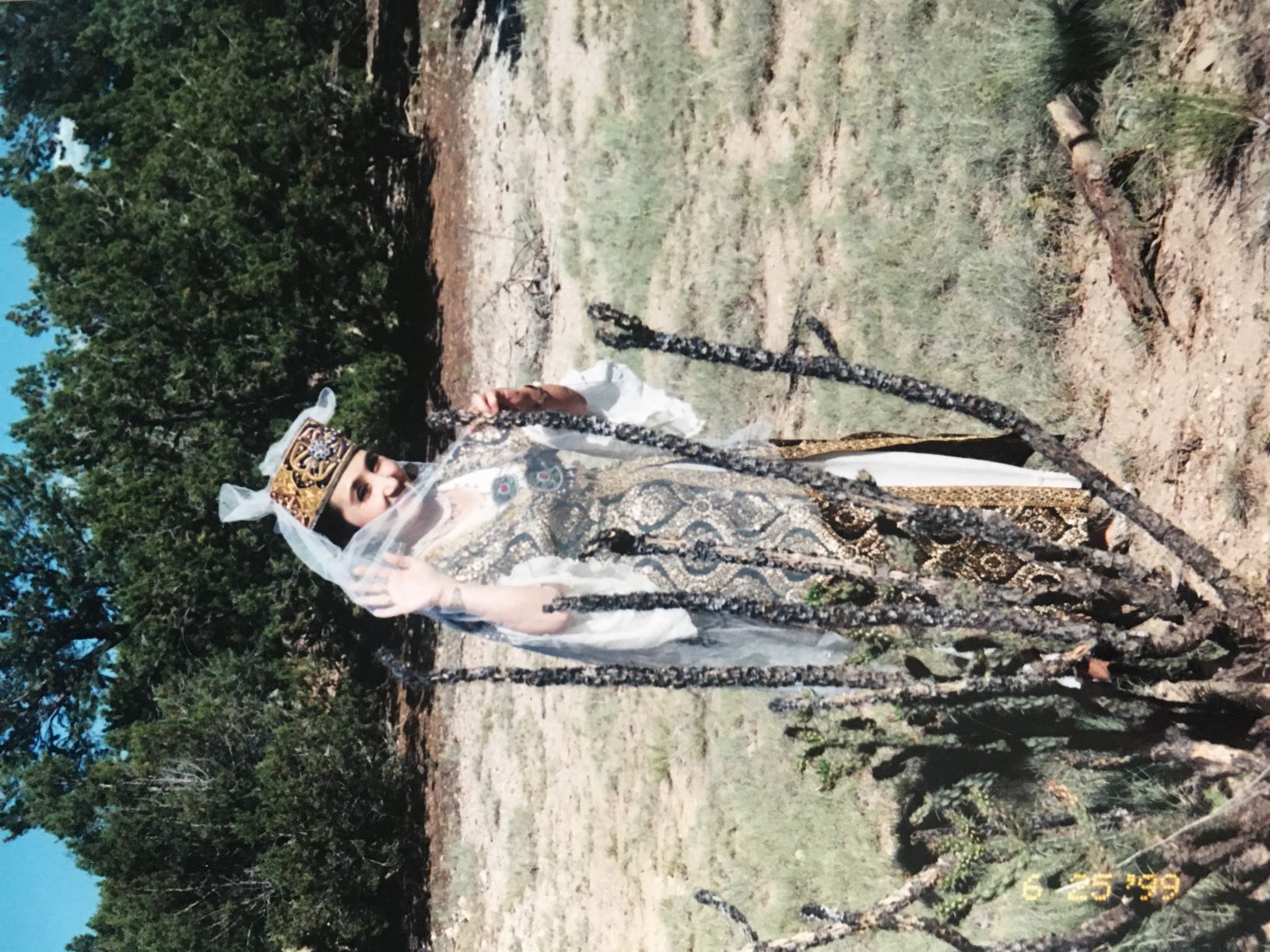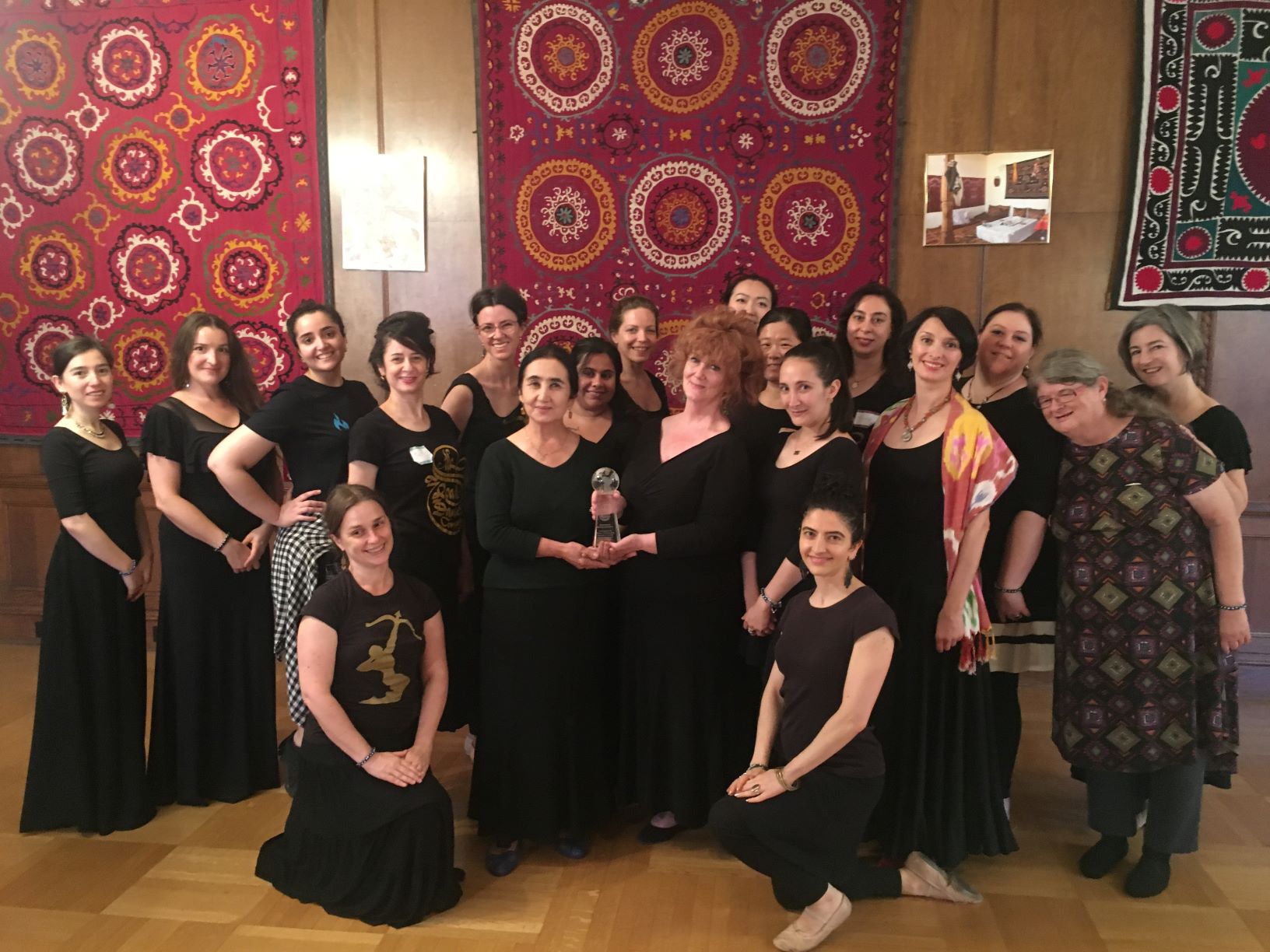Member of Silk Road Dance Company, Nilufar Rahmanova. Image courtesy of Central Asian Dance Camp.
“Yaxshi Raqqosa Bitta Joyda O’nayshi Mumkin”
(A Good Dancer Can Perform in One Place)
By Dr. Laurel Victoria Gray for MOZAIKA
In 2020 BC (Before Coronavirus), the 17th Central Asian Dance Camp (CADC) planned to bring a master instructor from Tashkent to the Uzbek Embassy in Washington, DC, to train American dancers. Last year’s camp, also held at the embassy, hosted People’s Artist of Uzbekistan, Kizlarhon Dusmukhamedova, honoring her with an award recognizing her 40 years of sharing Uzbek dance culture with Americans. Twenty participants from several states attended morning and afternoon dance classes and as well as lectures on Uzbek dance history and culture. During meals of Uzbek cuisine prepared by the embassy chef, dancers got acquainted with each other. An evening dance concert in the embassy provided camp participants and invited guests to experience in Uzbek dance performances in traditional costumes.

But now, COVID-19 brought a new challenge. Over the years, Central Asian Dance Camp had built a reputation as a “total immersion” in traditional culture. Could this rich, multi-faceted learning experience of still work in remote teaching environment?

The term “camp” may sound a bit odd for classes held in elegant surroundings of the Embassy of Uzbekistan, but the first camps were held at Synergy Ranch in Santa Fe, New Mexico, set on over 100 acres of high desert prairie looking for all the world like the location setting for a Western movie, complete with pinion and juniper trees. In these picturesque surroundings, participants truly escaped from the outside world to immerse themselves in Central Asian culture. The first camp, in 1996, hosted only a handful of participants, but the event soon grew, drawing many out-of-state participants, even a dancer from the Isle of Man.
With the goal of providing a cultural context for Central Asian dance, additional sessions included video viewing of dance performances by native artists – a rarity in the days before YouTube. Costuming sessions, with authentic pieces from the personal collections of the camp coordinators Travis Jarrell and Laurel Victoria Gray, allowed camper to dress in the unique regional styles of clothing worn for each of Uzbekistan’s three main “schools” of dance – Bukhara, Khorezm, and Ferghana. Evocating memories of childhood summer camps, there were also craft projects which provided materials and prototypes for participants to build their own peshanaband – the distinctive headdress of Bukharan women’s costumes. And, in 1998, Laurel secured an invitation for her mentor, People’s Artist of Uzbekistan, Kizlarkhon Dusmukhamedova, to teach at camp, giving dancers the opportunity to study with an Uzbek dance legend. Kizlarkhon’s feminine dance style and warm demeanor made her an immediate success with participants. Kizlarkhon became the centerpiece of future camps.


While the Santa Fe setting of the CADC made it accessible to West Coast participants, it proved less convenient for East Coast dancers. In 2000, the event relocated to Washington DC when Embassy of Uzbekistan graciously hosted the event in their stunning, historic building, allowing dancers to experience Uzbek hospitality first-hand.
Over the following years, CADC moved to various DC-area dance studios with wall-to-wall mirrors and professional dance floors. These studios also offered theatrical spaces for the concert performances that were important to CADC. In 2014, challenges with scheduling studio space and securing visas lead to a temporary hiatus. But when CADC started up again in 2019, a new group of participants registered, young women with Central Asian roots, hoping to reconnect with their culture of origin. Many of them had no formal dance training, but they had grown up hearing the music and seeing the dance. They understood the meaning and sentiment of the dance songs and quickly absorbed the lessons, effortlessly embodying the subtle and nuanced aspects of Central Asian women’s dance.


With the successful rejuvenation of CADC, participants established a sense of camaraderie and looked forward to continuing instruction together in 2020. The initial impulse of providing training in Central Asian dance for Americans now acquired another purpose, helping diaspora women connect with their roots.
Could these personal connections translate successfully to a virtual format? Would marrying new technology with old traditions create new connections, deepening understanding of Central Asian culture?
Instead of cancelling the planned in-person instruction, every aspect of CADC was reinvented with the assistance and cooperation of the Uzbek Embassy. Ambassador Javlon Vakhabov readily agreed to adapting the plan and promised to open the camp with an official greeting. In these remarks, he noted that “despite the pandemic” the many familiar and new faces on the Zoom meeting were “a clear sign of pure American interest in our culture and traditions.” The ambassador described Uzbek dance as “magnificent and magic” and “a vivid personification of the beauty of Uzbek culture.”[1] Following this formal launch of the camp, cultural attaché Akhror Burkhanov, led a virtual tour of the embassy building and its impressive collection of paintings and Uzbek folk art. He also assisted with organizing Zoom events from the embassy and Tashkent.



Two master teachers were engaged – People’s Artist of Uzbekistan, Kadyr Muminov, and Artistic Director of the Lazgi Ensemble, Shanazar Botirov. They had access in Tashkent to the needed remote technology and a large dance studio, but because of the nine-hour time difference between DC and Tashkent, classes were limited to morning sessions. This meant West Coast participants had to be ready to dance at 6 am! But this connection also added immediacy and, as participant Amy Barker-Wilson observed, it was “wonderful to be “chatting ‘live from Uzbekistan.’”
Teaching a foreign movement vocabulary to people in confined spaces presented challenges; although the Uzbek instructors taught in a spacious dance studio, the students themselves “zoomed in” from confined spaces within their homes. The past camp format of eight to nine hours of daily dance instruction and cultural presentations over the course of several days also morphed; dance sessions were limited to a shorter session on consecutive weekends. Experience had shown that 90-minute sessions worked best on Zoom; anything much longer and student energy and attention waned.
Another adaptation necessitated by the virtual format was the choice of dance offerings. Dramatic choreographies created for huge concert stages would simply not work. But according to an Uzbek folk saying, yaxshi raqqosa bitta joyda o’nayshi mumkin. (“A good dancer can dance in a single space.”) Traditionally, Uzbek female dances took place in the gendered women’s quarters known as the ich kari. The evolution to the Western concert stage occurred less than a hundred years ago, after the establishment of Soviet power in Central Asia. Historical dances, like the celebrated Khorezm Lazgi, were often performed in place. With an emphasis on muscular isolations and articulate gestures, Lazgi proved ideal for students in confined space. Precise and patient, dance instructor Shanazar Botirov demonstrated the characteristic and often pantomimic gestures and steps of Khorezm dance.

A Bukharan choreography, created by Kadir Muminov, drew on the signature style of the late Isakar Akilov, People’s Artist of Uzbekistan, and an acknowledged founder of Uzbek stage dance. The unique movements, gestures, and facial expressions of Bukharan dance provided students with challenging material. They had to practice the brilliant spins and turns of Bukharan dance in place, with the reminder that these turns could be expanded for the concert stage.
Both dances by Muminov and Botirov focused on correct body postures and precise placement. Dance camp participant and native of Uzbekistan, Ekaterina Lashina Neises, remembered first becoming enraptured by Central Asian dance as a child when she saw it performed at a wedding in Samarkand. For her, CADC was “an opportunity of a lifetime” and she is “grateful to Kadyr and Shahnazar for sharing the legacy of Uzbek dance with us and enriching our lives with beauty and happiness.”
The goal of “cultural immersion” required innovation as well. Since campers could not actually enjoy Uzbek cuisine in person, embassy chef Khamidulla Shamsutdinov gave a plov making demonstration so campers could prepare the dish at home. Camp participant Michele Stinson noted that “this cooking demonstration provided details up close that would be difficult for a group to see even in person. Watching the chef’s cooking techniques, seeing the tools he used, and viewing up close the timing, measurements, and ingredients for the recipe was really illuminating…” Inspired, several campers tried making plov at home.

Another aspect of the in-person CADC was the opportunity to acquire costumes along with other hard-to-find Central Asian items. A virtual Silk Road bazaar allowed participants to meet female entrepreneurs who presented their merchandise during a Zoom session, inviting questions about the traditional items from Central Asia, including fashion, home décor, embroidery pieces, and even face masks.
Cultural activities, sprinkled throughout the work week, augmented the dance classes. These included the lecture “Decolonizing Uzbek Dance: Honoring the Roots of Gesture,” which examined the development of Uzbek women’s dance in the 20th century.

An exciting highlight, a virtual excursion to the Home Museum of Tamara Khanum, familiarized camp participants with the life of this pioneer of Uzbek dance.


Since an in-person fashion show was not possible, a PowerPoint lecture presentation on costuming introduced regional costumes and jewelry styles. A “live action” demonstration helped dancers learn how to add extensions to their own hair, creating the beautiful, long braids so iconic for Central Asian dance.
Marina Abrams, author of the engaging children’s book Orange and Blue the World of Barzu discussed her next book project. Illustrated with slides from her field research, Abrams shared insights on traditional designs and the women who create them.
Trying to evoke one of the most magical elements of CADC, the camaraderie that developed between dancers, proved more challenging. In order to create a space for conversation and celebration, beloved camp instructor, Kizlarkhon Dusmukhamedova, became a special guest at a “virtual chaikhona[2],” joining on Zoom from her home in Tashkent. The remote meeting took place after the last dance session, coinciding with Uzbekistan’s 29th Independence Day Celebration. Past students surprised Kizlarkhon, honoring their beloved teacher with performances of dances she had taught them. A stunning cake decorated with the colors and symbols of the Uzbek flag looked quite tempting, but only virtual tasting was possible.


While organizing the virtual camp, with so many different aspects, proved to be more difficult and time consuming than the “in-person” model, it also allowed for broader attendance, Counting all the various offerings, a total of 44 people participated, including dance enthusiasts from Canada, UK, and New Zealand. For some, like Di Wang, who had “always been interested in learning Uzbek dance, it was a great opportunity.” Dancer Michele Stinson felt the collaboration with the Uzbek Embassy “showed how much we can all accomplish together and how important our partnership is for the continuation of traditional dance forms.” This partnership demonstrated “how our cultures create and continue to evolve the arts, and the impact of our combined strength to achieve great things in the arts and dance by remembering the past and carrying it into the future to transform our lives.”
The virus that forced people into their personal, 21st century ich kari, took participants back to the roots of Uzbek dance, reminding everyone that while COVID has isolated us, it has also brought us all closer together.\
After all, yaxshi raqqosa bitta joyda o’nayshi mumkin!
[1] from Ambassador Javlon Vakhabov’s greetings to Central Asian Dance Camp 2020, delivered on August 14th. Text supplied courtesy of the Embassy of Uzbekistan.
[2] Chaikhona-tea house







